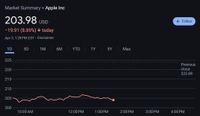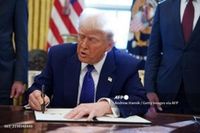On April 3, 2025, the Nasdaq 100 index faced a dramatic plunge, closing at 18,521.48, a staggering drop of 1,060.30 points or 5.41%. This steep decline came on the heels of President Donald Trump’s announcement regarding new reciprocal tariffs on several major trading partners, which sent shockwaves through the U.S. stock market.
The Nasdaq 100 index, which aggregates 100 core technology stocks listed on the U.S. stock market, had seen a slight increase of 0.75% the previous day before this unexpected downturn. Key stocks that managed to rise amid the chaos included CCEP (+2.76%), Exelon (+2.74%), Mondelez (+2.68%), AstraZeneca ADR (+2.35%), Kraft Heinz (+2.26%), and Intel (+2.05%). However, these gains were overshadowed by significant losses among semiconductor and tech stocks.
Notably, Microchip Technology saw a drastic decline of -16.80%, while Micron Technology fell by -16.09%. Other notable losers included On Semiconductor (-12.76%), Marvel Technology Group (-12.00%), Lam Research (-11.60%), and Nvidia (-7.81%). The declines were not limited to tech stocks; companies such as Warner Bros Discovery (-13.26%) and Trade Desk (-12.82%) also suffered substantial losses, contributing to the overall drop in the Nasdaq 100 index.
CNBC reported that the turmoil in the market was a direct result of Trump’s announcement of hefty reciprocal tariffs targeting countries such as South Korea (26%), China (34%), Japan (24%), the European Union (20%), Vietnam (46%), Taiwan (32%), and India (26%). Furthermore, starting April 9, 2025, a staggering 54% tariff will be applied to goods from China, compounding the fears of a trade war.
As the market opened on April 3, futures for the Nasdaq, Dow, and S&P 500 were already trending downward. The Nasdaq 100 futures index on the Chicago Mercantile Exchange recorded a 4.05% drop, settling at $18,957.25. S&P 500 futures were down 3.55% at $5,509.75, and Dow futures fell by 2.89% to $41,266.00. Analysts attributed these declines to the impending impact of Trump’s tariff imposition.
Trump’s administration had announced the reciprocal tariff plan just a day earlier, on April 2, 2025. The tariffs, which were formalized through an administrative order signed by Trump, also included rates for countries like Thailand (36%), Switzerland (31%), and Indonesia (32%). The announcement has raised concerns about a potential global trade war, with many fearing that such aggressive measures could lead to a significant economic downturn both domestically and internationally.
In the wake of the tariff announcement, U.S. big tech companies experienced severe stock declines. By 1:30 PM Eastern Time on April 3, the Nasdaq 100 index had already fallen by 4.6%. Apple, which manufactures key products in China and India, saw its stock drop as much as 10% during the trading session before settling at $203.98, down 8.9%. If the stock closes down 8% from the previous day, it would mark the largest decline for Apple since March 16, 2020, when it plummeted 12.86% due to the COVID-19 pandemic.
Apple’s market capitalization stood at $3 trillion 620 billion, raising concerns that it could dip below the $3 trillion threshold. Other major tech players also suffered significant losses, with Amazon falling by 7.7%, Meta by 6.8%, Nvidia by 6.6%, and Tesla by 5.2%. While Alphabet and Microsoft managed to limit their declines to 3.14% and 1.64% respectively, the overall sentiment in the tech sector was one of panic.
Bloomberg reported that Apple, despite years of efforts to stabilize its supply chain, now finds itself at the epicenter of a trade war and supply chain disruptions due to Trump’s new tariffs. Analysts Anurag Rana and Andrew Girard from Bloomberg Intelligence indicated that Apple is unlikely to raise prices to counteract the tariff impacts, suggesting that the new tariffs could put significant pressure on the company’s profit margins.
As the situation unfolds, the implications of Trump’s tariff strategy could extend beyond immediate stock market reactions. Economists warn that such measures could lead to increased costs for consumers and potentially stifle economic growth in the U.S. and abroad. The tech sector, which is particularly sensitive to economic fluctuations and tariffs, may continue to experience volatility as investors reassess the landscape.
In summary, the U.S. stock market, particularly the tech-heavy Nasdaq 100 index, is reeling from the shock of Trump’s new tariff policies. With key players in the technology sector experiencing significant declines, the ramifications of these tariffs could be felt across the global economy in the coming months. Investors and analysts alike will be watching closely to see how this situation evolves and what it means for the future of trade relations and economic stability.






